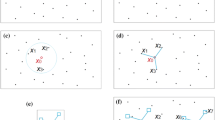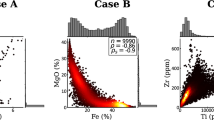Abstract
Earth science phenomena, in particular mineralization of ore deposits, can be characterized by the spatial and statistical features of multivariate information. The relationships among these variables are often complex, encountering non-linear features, compositional constraints, and heteroscedasticity. Capturing and reproducing their statistical and spatial distributions is essential for uncertainty management, allowing for better decision-making and process control. In this work, we present a novel spatial multivariate morphing transformation that maps the initial multivariate space into a spatially and statistically decorrelated multi-Gaussian space. The spatial structures of the Gaussian random variables are modeled independently, and values are simulated at unsampled locations using a conventional univariate geostatistical simulation algorithm. Multivariate features and relationships are reintroduced by mapping from the multi-Gaussian distribution into the initial space. The spaces are paired following the fundamentals of point cloud morphing using discrete optimal transport to minimize the distance between landmark points between spaces. New simulated values are mapped from the anchored multi-Gaussian space into the multivariate space via thin-plate spline interpolation conditioned to the k-spatially known closest samples. The effectiveness of the method is demonstrated in a 6-dimensional dataset with strong non-linear relationships and spatial continuity. The resulting multivariate statistical and spatial metrics have been compared with simulations obtained by projection pursuit multivariate transformation.

























Similar content being viewed by others
Code Availability
The landmark pairing is implemented using the Python Optimal Transport (Flamary et al. 2021) library. The wrapping code and the thin-plate spline interpolation are coded in Python 3.7. The open-source code can be accessed at https://code.engineering.queensu.ca/geomet-group/2022-Morphing under MIT License terms.
References
Agbolade O, Nazri A, Yaakob R, Abd Ghani AA, Cheah YK (2020) Landmark-based homologous multi-point warping approach to 3D facial recognition using multiple datasets. PeerJ Comput Sci 6:e249
Barnett RM, Manchuk JG, Deutsch CV (2014) Projection pursuit multivariate transform. Math Geosci 46(3):337–359
Bookstein FL (1989) Principal warps: thin-plate splines and the decomposition of deformations. IEEE Trans Pattern Anal Mach Intell 11(6):567–585
Bookstein FL (1997) Landmark methods for forms without landmarks: morphometrics of group differences in outline shape. Med Image Anal 1(3):225–243
Bourgault G (2014) Revisiting multi-Gaussian kriging with the Nataf transformation or the Bayes’ rule for the estimation of spatial distributions. Math Geosci 46(7):841–868
Chiles JP, Delfiner P (2009) Geostatistics: modeling spatial uncertainty, vol 497. Wiley, Hoboken
David M (1988) Handbook of applied advanced geostatistical ore reserve estimation. Elsevier, Amsterdam
Davis MW (1987) Production of conditional simulations via the LU triangular decomposition of the covariance matrix. Math Geol 19(2):91–98
de Figueiredo LP, Schmitz T, Lunelli R, Roisenberg M, de Freitas DS, Grana D (2021) Direct multivariate simulation-a stepwise conditional transformation for multivariate geostatistical simulation. Comput Geosci 147:104659
Desbarats A, Dimitrakopoulos R (2000) Geostatistical simulation of regionalized pore-size distributions using min/max autocorrelation factors. Math Geol 32(8):919–942
Deutsch CV, Journel AG (1992) Geostatistical software library and user’s guide. New York 119(147)
Donato G, Belongie S (2002) Approximate thin plate spline mappings. In: Heyden A, Sparr G, Nielsen M, Johansen P (eds) Computer vision – ECCV 2002. ECCV 2002. Lecture notes in computer science, vol 2352. Springer, Berlin, Heidelberg, pp 21–31
Emery X (2008) A turning bands program for conditional co-simulation of cross-correlated Gaussian random fields. Comput Geosci 34(12):1850–1862
Flamary R, Courty N, Gramfort A, Alaya MZ, Boisbunon A, Chambon S, Chapel L, Corenflos A, Fatras K, Fournier N, Gautheron L, Gayraud NTH, Janati H, Rakotomamonjy A, Redko I, Rolet A, Schutz A, Seguy V, Sutherland DJ, Tavenard R, Tong A, Vayer T (2021) Pot: python optimal transport. J Mach Learn Res 22(78):1–8
Genton MG, Kleiber W (2015) Cross-covariance functions for multivariate geostatistics. Stat Sci 30(2):147–163
Gómez-Hernández JJ, Journel AG (1993) Joint sequential simulation of multigaussian fields. In: In: Soares A (ed) Geostatistics Tróia ’92. quantitative geology and geostatistics, vol 5. Springer, Dordrecht, pp 85–94
Gomez-Hernandez J, Srivastava R (2021) One step at a time: the origins of sequential simulation and beyond. Math Geosci 53:193–209
Goovaerts P (1997) Geostatistics for natural resources evaluation. Oxford University Press, Oxford
Journel AG (1974) Geostatistics for conditional simulation of ore bodies. Econ Geol 69(5):673–687
Journel AG (1989) Fundamentals of geostatistics in five lessons, vol 8. American Geophysical Union, Washington
Journel AG, Huijbregts CJ (1978) Mining geostatistics. Academic Press, London
Leuangthong O, Deutsch CV (2003) Stepwise conditional transformation for simulation of multiple variables. Math Geol 35(2):155–173
Linsen L (2001) Point cloud representation. Interner Bericht. Fakultät für Informatik, Universität Karlsruhe, Buch
Liu M, Sheng L, Yang S, Shao J, Hu SM (2020) Morphing and sampling network for dense point cloud completion. In: Proceedings of the AAAI conference on artificial intelligence, vol 34, pp 11596–11603
Manchuk JG, Deutsch CV (2012) A flexible sequential gaussian simulation program: USGSIM. Comput Geosci 41:208–216
Marcotte D (2016) Spatial turning bands simulation of anisotropic non-linear models of coregionalization with symmetric cross-covariances. Comput Geosci 89:232–238
Mariethoz G, Caers J (2014) Multiple-point geostatistics: stochastic modeling with training images. Wiley, Hoboken
Minniakhmetov I, Dimitrakopoulos R (2017) Joint high-order simulation of spatially correlated variables using high-order spatial statistics. Math Geosci 49:39–66
Mustapha H, Dimitrakopoulos R (2010) High-order stochastic simulation of complex spatially distributed natural phenomena. Math Geosci 42:457–485
Perrot M, Courty N, Flamary R, Habrard A (2016) Mapping estimation for discrete optimal transport. In: Advances in neural information processing systems, vol 29. Curran Associates, Inc.
Peyré G, Cuturi M (2019) Computational optimal transport: with applications to data science. Found Trends® Mach Learn 11(5–6):355–607
Rohr K, Stiehl HS, Sprengel R, Buzug TM, Weese J, Kuhn M (2001) Landmark-based elastic registration using approximating thin-plate splines. IEEE Trans Med Imaging 20(6):526–534
Santambrogio F (2015) Optimal transport for applied mathematicians, vol 55(58–63). Birkäuser, NY, p 94
Solomon J (2018) Optimal transport on discrete domains. In: AMS short course on discrete differential geometry
Stegmann MB, Delgado-Gomez D (2002) A brief introduction to statistical shape analysis. Informatics and mathematical modelling. Technical University of Denmark, Lyngby, Denmark
Switzer P (1985) Min/max autocorrelation factors for multivariate spatial imagery. Department of Statistics, Stanford University, Stanford, California
Thanou D, Chou PA, Frossard P (2016) Graph-based compression of dynamic 3D point cloud sequences. IEEE Trans Image Process 25(4):1765–1778
van den Boogaart KG, Mueller U, Tolosana-Delgado R (2017) An affine equivariant multivariate normal score transform for compositional data. Math Geosci 49:231–251
Verly G (1993) Sequential Gaussian co-simulation: a simulation method integrating several types of information. In: Geostatistics Troia’92. Springer, Dordrecht, pp 543–554
Villani C (2009) Optimal transport: old and new. A series of comprehensive studies in mathematics, vol 338. Springer Berlin, Heidelberg
Wackernagel H (1989) Description of a computer program for analyzing multivariate spatially distributed data. Comput Geosci 15(4):593–598
Wackernagel H (2003) Multivariate geostatistics: an introduction with applications. Springer, Berlin
Wahba G (1990) Spline models for observational data. SIAM, Philadelphia
Wood SN (2003) Thin plate regression splines. J R Stat Soc Ser B (Stat Methodol) 65(1):95–114
Yan Z, Hu R, Yan X, Chen L, Van Kaick O, Zhang H, Huang H (2020) Rpm-net: recurrent prediction of motion and parts from point cloud. ACM Trans Graph 38(6):1–15
Acknowledgements
We acknowledge the support of SRK Consulting Canada, the Mitacs Accelerate Program, and the Natural Sciences and Engineering Research Council of Canada (NSERC), funding reference numbers RGPIN-2017-04200 and RGPAS-207-5057956. Special thanks to Raimon Tolosana-Delgado and Oy Leuangthong for their valuable theoretical and practical advice. We are grateful for the thoughtful comments and suggestions of three expert reviewers who contributed to improve the quality and readability of the manuscript.
Author information
Authors and Affiliations
Corresponding authors
Ethics declarations
Conflict of interest
The authors declare that they have no known competing financial interests or personal relationships that could have appeared to influence the work reported in this paper.
Appendices
Appendix A: Thin-Plate Spline Interpolation
Physically inspired by the bending energy function of a two-dimensional steel sheet under small deformations, the integral bending norm or integral quadratic variation of the energy E(f) has the form
It has been often applied in computer vision applications (Donato and Belongie 2002; Agbolade et al. 2020) on three-dimensional object surfaces under the form
with a natural extension to d-dimensions and for an arbitrary order m of derivatives (Wood 2003; Rohr et al. 2001) as
with \(v_1, \ldots , v_d\) being positive integers (Wahba 1990). Note that with \(d=m=2\), we recover Eq. 8, and with \(d=3, m=2\) we recover Eq. 9.
The minimum number of landmark points must be greater than \(\dfrac{(d+m-1)!}{d!(m-1)!}\) (Rohr et al. 2001). Thus, for \(m=2\) and \(d \ge 1\), the number of landmark points must be greater than \(d+1\). In this work, we consider the case where \(m=2\) and \(d \ge 1\).
For a detailed explanation on bending energy function and minimum landmark point selection, we refer readers to Wahba (1990) and Rohr et al. (2001).
Appendix B: Bivariate Comparison Between PPMT and the Morphing Transformation
Full comparison between samples and a single realization from PPMT and Morphing transformation are provided on Figs. 26, 27, and 28, complementing results obtained in Sect. 5.5.
Rights and permissions
Springer Nature or its licensor (e.g. a society or other partner) holds exclusive rights to this article under a publishing agreement with the author(s) or other rightsholder(s); author self-archiving of the accepted manuscript version of this article is solely governed by the terms of such publishing agreement and applicable law.
About this article
Cite this article
Avalos, S., Ortiz, J.M. Spatial Multivariate Morphing Transformation. Math Geosci 55, 735–771 (2023). https://doi.org/10.1007/s11004-023-10058-w
Received:
Accepted:
Published:
Issue Date:
DOI: https://doi.org/10.1007/s11004-023-10058-w







